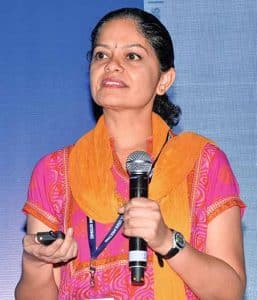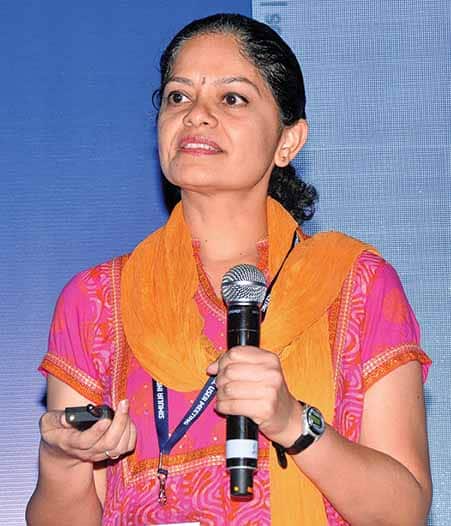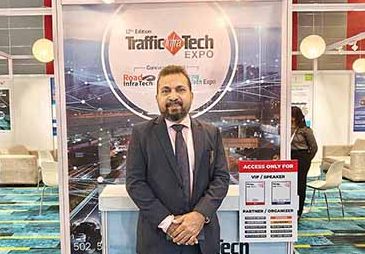In an UpFront conversation, Renuka Srinivasan, Sales Director (SIMULIA) – Dassault Systèmes speaks to Sumesh Soman on the importance of crash test simulation and how active and passive safety is now becoming sought after in the Indian automotive market.
 Q. What is the future of crash test optimisation in the Indian automotive industry? How is it linked to Dassault Systemes in India?
Q. What is the future of crash test optimisation in the Indian automotive industry? How is it linked to Dassault Systemes in India?
A. Crash worthiness is gaining significance within the automotive sector as consumers are now more conscious of safety. The Government of India, assisted by bodies like the Automotive Research Association of India (ARAI), already have stringent regulations in place on ehicular safety. The crash regulations have also expanded to consider both occupant and pedestrian safety. With the emphasis on electric vehicles, we can expect newer regulations specific to the newer energy sources that these vehicles are using, whether it is batteries, fuel cells or even hydrogen fuel. Regulations will also be needed for charging stations, swapping points and for recycling of used batteries.
A vehicle crash is a highly complex, nonlinear event involving large physical deformation of the structure in a fraction of a second. Dassault Systemes’ leading solver technologies allow simulation of the vehicle crash including advanced material behaviour, energy absorption and “dummy” simulation. Our technology is used for design exploration in the ideation or conceptual stage and also for high-fidelity predictive crash simulation during the detailed design phase. The model-based approach on the 3DEXPERIENCE platform from Dassault Systemes, allows for a “single source of truth,” with multiple departments working on the same models and data to cut development time and avoid wasting resources. As a software OEM, we understand how vehicle behaviour and performance during a physical (regulatory) test can be simulated effectively and the interpretation of these simulation results. We are always open to participating in standing committees organised by regulatory bodies and sharing our knowledge in this regard.
Q. With EVs thrown into the mix, how will it affect crash test from that of an ICE vehicle?
A. Given the rapid growth of the electric vehicle market, regulations will also evolve accordingly. For example, the Union Ministry of Road Transport and Highways (MoRTH)recently announced additional safety requirements for batteries which will come into effect from October 01, 2022.
Besides structural impact, one also has to consider two aspects which are far more critical when we consider EVs. The first one is the battery itself. Regulators will now have to take into consideration aspects like electrolyte leakage, battery discharge post an event, etc. While we have learned over time to negotiate the dangers associated with flammable fluids for non-electric vehicles and made those vehicles exponentially safer, we now must negotiate the electrical vehicle space similarly.
 The second aspect is the overall electrical safety of the vehicle. An electric vehicle contains an electric powertrain with a high voltage bus and a rechargeable energy storage system. Post a crash, automatic disconnect and or isolation of the electric circuit is required. The overall electric protection system should not be compromised. The electrical safety of the vehicle is of high importance so that passengers and first responders in the case of a crash are not impacted.
The second aspect is the overall electrical safety of the vehicle. An electric vehicle contains an electric powertrain with a high voltage bus and a rechargeable energy storage system. Post a crash, automatic disconnect and or isolation of the electric circuit is required. The overall electric protection system should not be compromised. The electrical safety of the vehicle is of high importance so that passengers and first responders in the case of a crash are not impacted.
Q. While at its nascent stage, how will the crash worthiness simulation contribute to OEMs? How reliable is the data when compared to a tangible crash test?
A. In the case of ICE engines, vehicle manufacturers have been doing crash simulations for several years. As crash regulations have become more stringent, automotive OEMS have increased their virtual exploration of the vehicle structure, materials and restraint systems to improve the crash worthiness of their automobiles. Simulation allows OEMs to understand the impact of a design change – say, thickness change of sheet metal – on the vehicle performance and to virtualy test the vehicle. Vehicle requirements targets – safety, performance, fuel efficiency (or range for eV), and cost – can sometimes be contradictory and OEMs rely on simulation to explore the design options and arrive at an optimal solution.
Dassault Systemes simulation apps. have been used to simulate various types of crash simulations (e.g. frontal impact, side impact, etc.) by automotive OEMs. We have developed and validated the technology against physical tests, starting from crushing simple metal tubes to crash of full vehicles including restraints and dummies. A combination of advanced material models, robust and efficient solver technology, as well as Industry best practices (Industry Process Experiences or IPEs), allows us to provide predictive crash simulation. We continuously innovate and update our software to include the latest advances in materials, high-performance computing and automotive technology. Our solutions allow for high-fidelity (i.e. detailed) models of full vehicles to be run on a large number of cores either on-premise or on-cloud, resulting in an accurate and predictive crash simulation – so the OEM can be confident that they will pass the physical crash test the first time itself.
Q. With OEMs now focusing on safety as one of the key parameters for a vehicle, explain the role of crash test simulation in today’s age and trend.
A. Consumers have become very conscious of safety ratings. In addition, automotive OEMs have become more conscious of their “Brand image” and the need to avoid any costly recalls. All of this means crash worthiness has become more important, overall. Crash worthiness is about designing a path where the structure can deform safely, absorbing the excess energy, while still leaving space for the occupant inside. This needs to be considered right from the initial design of the vehicle itself. During the ideation or conceptual phase, the OEM wants to explore multiple design variations and the need is for a simple model that can provide results in a short time. To ensure a rapid crash worthiness assessment, Dassault Systemes offers a highly abstracted model and meta data from Machine Learning. The detailed design phase addresses how much the simulation can predict the real behaviour of the vehicle and ensure the physical test is passed the very first time. Our simulation technology in both cases (conceptual as well as detailed design) can immensely benefit and support automotive OEMs.
Q. What are the advantages of crash worthiness simulation over a tangible test along with its application for passenger as well as commercial vehicles?
A. There is always a race to be the first to bring one’s vehicle into the market. To achieve that, development time must be reduced, while still passing the regulations. This is where simulation really makes a difference. A virtual test (i.e. a simulation of the physical regulatory test on the computer) can help assess the vehicle’s performance. Changes can then be incorporated into the design in advance, and the changed configuration tested. Thus, this helps manufacturers discover any failures ahead of time, and be confident that they will pass the regulatory tests the first time itself.
Passing regulations is only one step. This needs to be done while keeping in mind cost-related criteria. There is always a trade-off while designing a vehicle. Some safety features may adversely impact the fuel efficiency or range. Finding the best balance for a car design involves making trade-offs between several factors. With help of our 3DEXPERIENCE platform, these trade-offs can be simulated allowing for various factors (parameters) to be studied to make informed design-related decisions.
Q. Since there’s no engine under the hood of the vehicle, an EV crash could be different from an ICE vehicle. Explain how the crash and simulation will affect the occupants considering the impact on the battery as well?
A. EV vehicles are structured differently. For instance, the battery is usually located on the floor of the vehicle, resulting in a lower centre of gravity when compared to an ICE vehicle. Fire hazards need to be considered in the case of both types of vehicles. However, OEMs have years of experience dealing with safety hazards related to ICE vehicles. Manufacturers now need to do the same with battery-powered vehicles.
Currently, auto manufacturers are learning how to deal with these hazards in different geographic environments as well. Alongside this, understanding battery resilience is also important, which is why nail penetration tests should be conducted alongside a variety of other tests like fire, vibration, drop, etc. In addition, aspects like automatic switch off battery post a crash, safe discharge of a battery post an event, electrolyte leakage, and electric safety of the vehicle (when some components could have got exposed due to the crash) are all aspects that OEMs and regulators consider.
Q. What are the challenges faced by Indian OEMs to make products in even shorter time frames?
A. As I mentioned earlier, there is always a rush to be the first in the market. In the case of EVs, manufacturers aim to grab the highest market share but are also working with technology that is new and evolving. With ICE vehicles, OEMs have developed a formal Design Verification Plan (DVP) ( or best practices) over a couple of decades. While many of these DVPs would apply for EVs also, new DVPs will be needed for new components, e.g. an eDrive. In addition, some existing components could be modified for EVs. For example, regenerative braking allows the excess energy during the braking to be used to charge the battery (i.e. kinetic energy converted to chemical). The proportion and importance of software (e.g. Battery monitoring system or BMS) is also increasing, and is a key differentiator in vehicle performance. Lastly, in some cases, OEMs are also working with new vendors (e.g. a battery or motor supplier) and need to develop a trust-based partnership with them for a collaborative vehicle design.
On the other hand, consumers expect a vehicle performance (riding experience) that is similar to an ICE vehicle, while still expecting all safety precautions to be met. Further, the government has also been announcing newer regulations to address some of the aspects unique to EVs.
In summary, OEMs are working with newer vehicle technology, and yet need to meet stringent (and evolving) regulations, meet sophisticated consumer expectations, while meeting reduced project development timelines. This is where Dassault Systemes, with our global exposure from working with EV leaders worldwide, and our industry-proven technology, is assisting Indian OEMs. Besides software, we also provide Industry process experiences as well as services (or outcome-based engagements) to assist our customers to meet these challenges. ACI









Leave a Reply